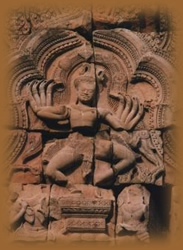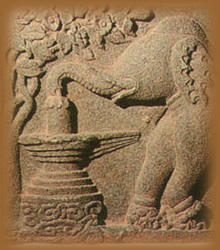 |
 |
Lord
of the dance That Phanom Rung, Thailand |
Shiva
lingam Quanzhou, China |
Each month, Hindus observe the night of the new moon as Shivratri, i.e. dedicated to the worship of Shiva. The new moon festival in the month of Magha—celebrated as Mahashivratri—is held to be particularly important, as it is believed that Shiva performed the tandava on this night, the cosmic dance of creation, preservation and destruction.
The word Shiva means ‘auspicious’. To his worshippers, he is known as Mahadeva, the ‘great God’, a totality of being conceived in terms of opposites: light and dark, good and evil, creation and destruction, rest and activity, mild and terrible, female and male. One of his images is that of the cosmic dancer, Shiva-nataraj, whose dance brings the cosmos into being, sustains it, dissolves it, and then recreates it anew. A more common representation of the god, however, is the lingam*, an abstract symbol of his regenerative powers. As ‘destroyer’, Shiva is seen as one facet of the Hindu trinity along with Brahma, the creator, and Vishnu the preserver. He goes by many other names as well. As Paramatman, he is the absolute; as Yoganath he is the ‘lord of yoga’, becoming teacher, path and goal—and as such he becomes Adi Guru, the ultimate guide of those seeking enlightenment.
For most Hindus, however, Shiva is a compassionate personal god, the dispenser of both spiritual and material blessings. From early in the morning of Mahashivrati, temples are filled with devotees who come to offer puja to the Shiva lingam. Throughout the day and night devotees observe a fast, in some cases even obstaining from water. This day is also believed to be the occassion that Shiva married the goddess Parvati. As such it is considered especially auspicious for women; married women pray for the well being of their husbands and sons, while those not yet married pray for a spouse like Shiva, considered to be a model husband.
Hymns to the god are sung with great fervour and devotion, and a mantra—Om Namah Shivaya—is repeated in the belief that uttering the god’s name with the proper devotion will ensure release from sin, and liberation from the endless cycle of birth/death/rebirth.
Devotees bathe at sunrise, preferably in the Ganga or other holy body of water, a rite of purification that is an important part of all Hindu festivals. Afterwards worshippers move to the temple to bathe the lingam and decorate it with flowers. Shiva is believed to be a very hot tempered god, and hence things that have a cooling effect are offered to his image: bael leaves, milk, sandalwood and jujube. By bathing and embracing the lingam, lighting diya,** burning incense, and ringing the temple bells, devotees engage all of their senses, thus making themselves acutely aware of the universe to which they belong, a universe sustained and renewed by Shiva’s never-ceasing dance.
**Small earthen lamps usually made of clay and with a cotton wick. The fuel in the lamp is oil or ghee.